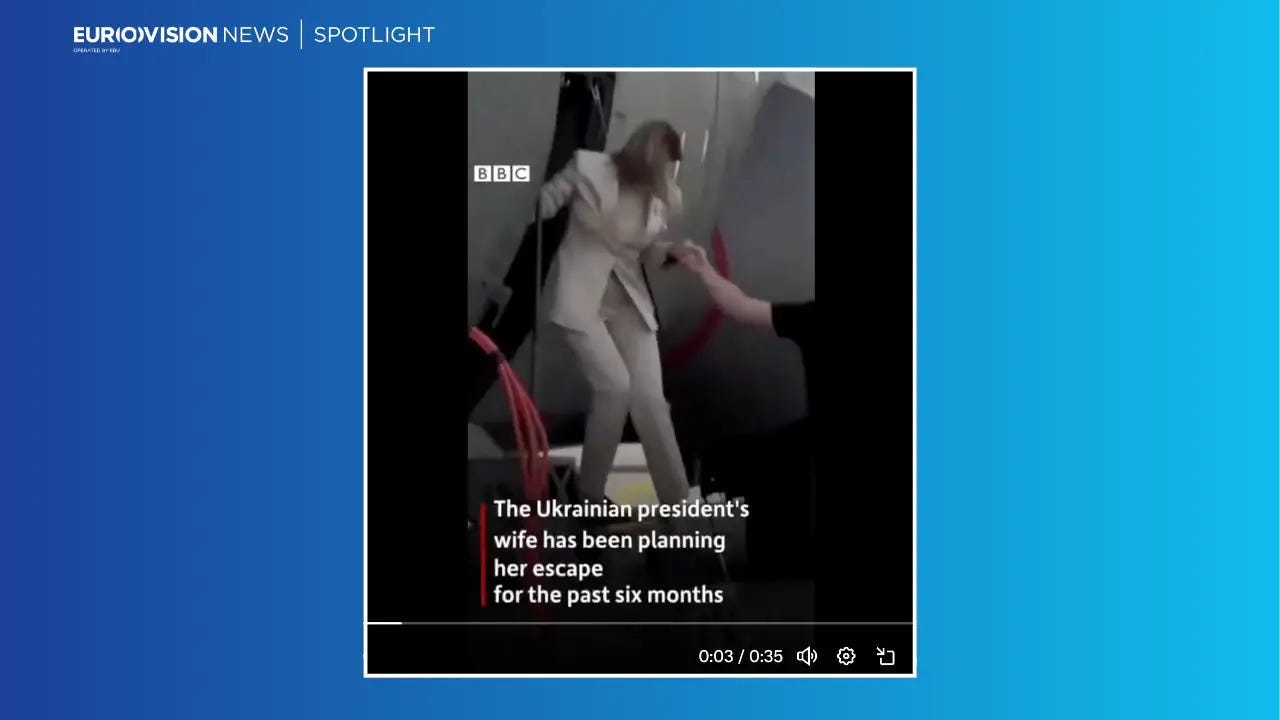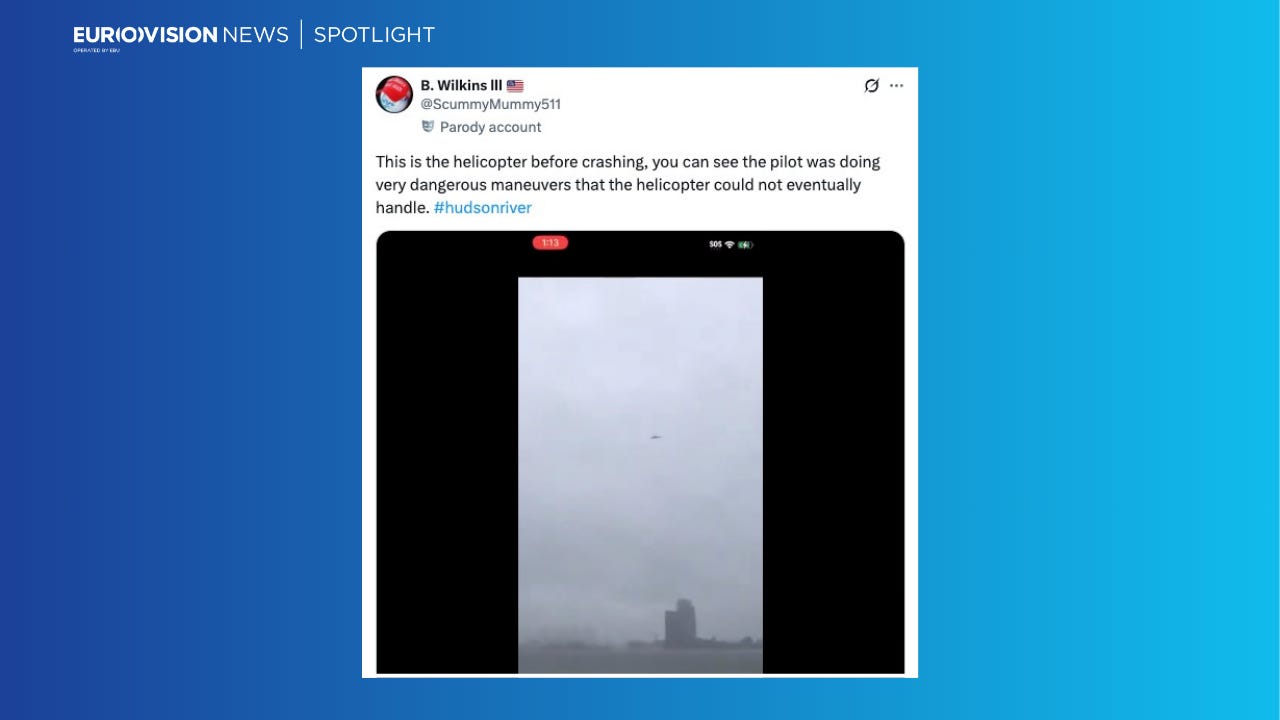Fact-Check Dispatch: Fake Zelenskyy reports using public broadcaster brands, bizarre tattoo ID error, and NYC helicopter tragedy exploited
Issue 15 of the Spotlight Fact-Check Dispatch
It was a week dominated by news stories about the on-again, off-again U.S. tariffs, but that didn’t mean that stories beneath the fold escaped the misinformation minefield.
Public service broadcasters in Europe and further afield were directly affected when their branding and logos were used to spread deliberately misleading information about Volodymyr Zelenskyy and his family.
In New York City, where a devastating helicopter crash claimed the lives of an entire family of Spanish tourists, opportunistic aggregator accounts fished for engagement using clips from another air incident several years ago.
And more broadly in the U.S., the hum of stories continued about people being picked up off the streets and flown to detention centres abroad, accused of gang membership or other crimes. The plot thickened when an English man found his own tattoo on an official U.S. government document being used by authorities to identify Venezuelan gang members.
Here’s our fact-check dispatch.
Public broadcaster logos misused in Zelenskyy disinformation campaign
It’s a trend that we’ve seen again and again: false stories and conspiracy theories about Volodymyr Zelenskyy and his family’s covert business operations, personal lives, and wealth.
In this case, it was a narrative about Olena Zelenska, the Ukrainian First Lady. Supposed screenshots of UK newspaper front pages and a video appearing to be a BBC News production were widely shared, claiming that Zelenska’s whereabouts were unknown and that she was planning to flee her war-torn country.
The alleged “BBC” video said that Zelenska had been planning her departure from Ukraine for the last six months, and now her location was unknown after a “personal group of SBU handlers” learned of her plans to escape, due to her “aggravated relationship” with her husband.
Jenny Hauser of the Eurovision Social Newswire writes that there was no evidence the BBC ever published the video, and adds that “the account has published anti-Ukraine disinformation before”.
Hauser also pulled up some examples of Zelenska’s official engagements around the time when she was supposedly missing in action, surmising: “Olena Zelenska’s whereabouts were not unknown at the time the forged BBC video was published and there is nothing to support the claim that she has fled Ukraine and has taken refuge in another European country.”
Javier Menasalvas from Spain’s VerificaRTVE also looked into this story, writing: “The Center for Countering Disinformation in Ukraine reported on the social network X about the spread of the fake video with the BBC logo on pro-Russian Telegram channels. ‘In reality, no such video exists on any of the official BBC platforms, which proves that this is a false and absurd Russian disinformation attempt about the alleged escape of the first lady,’ they stated in a message.”
It’s worth mentioning that this genre of story about the family of Ukraine’s leader is not a new phenomenon. In 2022, soon after Russia’s full-scale invasion of Ukraine, a video of a young woman crying was spreading on social platforms, purporting to show President Zelenskyy’s daughter and claiming that she had fled to Poland. DW debunked the clip at the time.
And what’s this about Volodymyr Zelenskyy buying a majority share in a South African company? Nele Baeyens from Belgium’s VRT writes about an example of a false story that was viewed over a million times, featuring the branding of SABC News, South Africa’s public broadcaster.
Using reverse image searches, Baeyens discovered that the video was a “hodgepodge of news clips with the SABC News logo”, including real footage showing Zelenskyy stepping out of a plane when he visited a D-Day ceremony in France, and his meeting with the South African president two years ago at a climate summit. Furthermore, the mining company Northam Platinum Holdings confirmed to a number of fact-check organisations that the story was not true.
In Sweden, a completely different story appeared in an imitation of national broadcaster SVT’s website. Maria Lapenkova and Hannes Forssell of SVT Verified reported on the AI-generated image and false text, which was being shared around on X.
They write: “The fake image in a headline and an introduction in the style of SVT claims that a man in Borlänge was able to get a driver's license even though he cannot read by taking a customised theory test with colours and symbols.”
The red flags initially became apparent when the article referenced SVT Borlänge, which does not exist as an editorial office or subdivision of their newsroom. They used AI detection tools to back up their suspicion that the image was generated by AI.
This tactic of mimicking trusted broadcasters can deceive audiences and amplify false narratives with greater authority.
Tattoo trouble: UK man's ink mistaken for Venezuelan gang symbol in U.S. deportation documents
Do people with tattoos need to start worrying about their upcoming holidays to America? That was the question one British man was asking himself when he found an image of his very own tattoo on a U.S. government document being used to identify members of a notorious Venezuelan gang to be deported and sent to an offshore jail.
The bizarre story was covered by Jake Horton from BBC Verify, who writes: “Pete Belton, 44, from Ilkeston says he was shocked to find his forearm featured in a Department of Homeland Security document used to help identify alleged members of Tren de Aragua, a transnational criminal organisation.”
Belton, who called himself “an average middle-aged man from Derbyshire”, said his clock tattoo represents the time and date of his daughter’s birth. The image used in the government document was, in fact, the picture posted by the artist who gave him the body art, Horton was able to determine using reverse image searching.
“The same image of Mr Belton's tattoo also appeared in a September 2024 report by the Texas Department of Public Safety about TdA activity,” Horton writes.
The U.S. Immigration and Customs Enforcement (ICE) said it hasn’t deported anyone solely based on their tattoos, but the designs people have inked on their skin could play a large role in an arrest and deportation. And lawyers have sounded the alarm about their clients being wrongfully identified and picked up off the street, including one report of a man with a crown tattoo that was said to be inspired by the Real Madrid logo.
This case highlights the dangers of relying on superficial visual cues for identification and the potential for wrongful targeting by authorities.
Old crash footage exploited in wake of New York helicopter tragedy
As with any disaster where there’s a huge public appetite for eyewitness footage, there were examples of misrepresented content in the tragic story of a Spanish family and their pilot who were all killed when a sightseeing helicopter crashed into New York City’s Hudson River on April 10.
Jenny Hauser from the Eurovision Social Newswire came across footage that was being circulated in the English language, claiming to show the helicopter moments before crashing.
VerificaRTVE looked into examples of the same clip being shared in Spanish posts. Both of the fact-checks led back to the same conclusion: The footage originated from an eyewitness who was on the banks of New York’s East River in 2019, when another helicopter crash took place.
The Spanish broadcaster geolocated the older video, and found that the trajectory and location were different from the recent crash. Hauser used reverse image searching to find the original, and also noted that the weather on the day of the recent crash was different to that seen in the clip.
Exploiting tragic events with misleading visuals can generate confusion and hinder accurate understanding of events.
As this week's Fact-Check Dispatch demonstrates, the fight against misinformation requires constant vigilance. By staying informed and critically evaluating the information you encounter, you play a vital role in ensuring a more truthful information ecosystem.







